By the stars! I just discovered a brand new telescope lens in the back room, we have to go star gazing, we might even see some planets!
Today, planulas, we're gonna be looking at why it's impossible to look at planets in any solar system but Camphor, and how we're going to be stubborn and still be able to observe them.
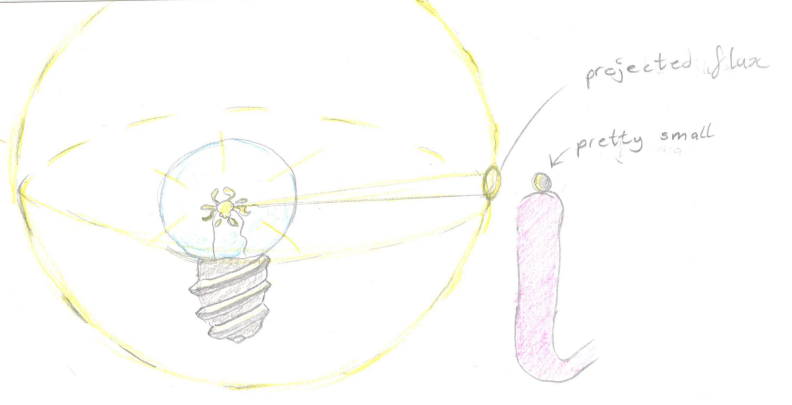
First off we're gonna introduce two terms which will be relevant for why it's challenging to observe extraterrestrial planets, but will also be the way we are able to solve it!
As you can see by the picture to the right a star, here represented by a light bulb, will release a cetrain amount of light per second. This is known as the luminocity and can be written as \(L = \frac{\Delta{E}}{\Delta{t}}\) or simply the energy released from the star over a certain amount of time. Now is we don't want to look at the whole star, but rather a small area, we'll be looking at the flux, simply written \(F = \frac{\Delta E}{\Delta A\Delta t} \space or \space F = \sigma T^4\) in other words flux is a certain portion of the energy the star beams through a selected area. Now if we were to measure this flux over the whole yellow dome you see above we would need to divide the luminocity by the surface of this bigger orb, with radius r: \(F = \frac{\Delta E}{\Delta A\Delta t}= \frac{L}{\Delta A}= \frac{L}{4\pi r^2}\) if we were to make an analogy for a planet in this example, say the styrofoam ball being held by the tentacle in the picture. We can intuitively say it will be recieving only a tiny fraction of the light from the bulb, as it's cross section only is able to cover a tiny protion of the yellow sphere. This might not seem like a huge issue, cause the same applies to our own system, and we're able to spot planets just fine. The issue lies in the distance between us and
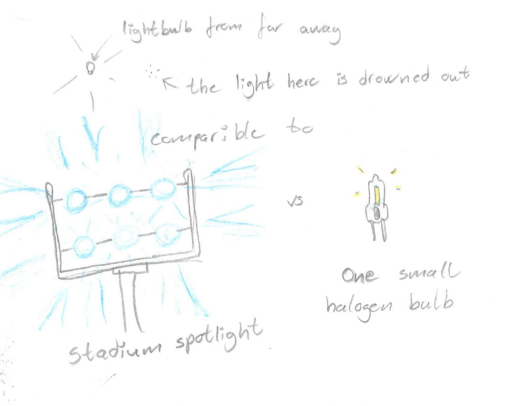
the other system, cause in our own the planets are able to move quite a few degrees away from our star, hence the star won't ovewthelm the light from them, but when the system is a couple of lightyears away, we're looking at an angle approaching 0. Think of it the same objects getting 'smaller' as you move away from them. This means, when observing interstellar planetary systems, the flux reaching is is from both planet and star, but the star has a waaaay greater flux, as exemplified in the left picture, but in reality the effect is even more extreme.
Day 483; I thought I spotted a very fast moving neutron star with three planets in orbit racing over the night sky... Turns out it was a dustbunny with a few grains of dust in my lab, I'll need to do some vacuuming.
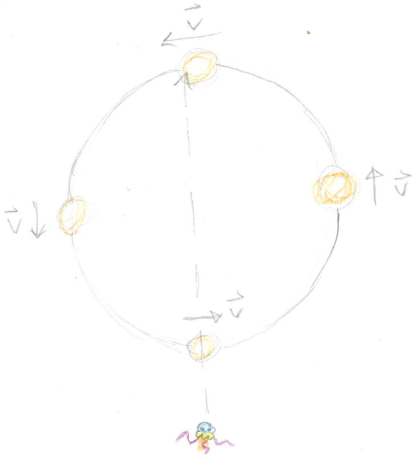
Well, since we can't observe planets directly, how do we go about discovering them? It's not like we're just guessing there are planets around other stars right? Well to a certain extent we are able to look at the planets. But we've had to invent creative ways to do so. You see the star is affected by the gravitational pull of the planets orbiting it, and this will mean it starts orbiting a centre of mass, which we will explain in the next post. Since the sun has this orbit we can observe a certain change in it's emmited light from the dopler effect. However, we are limited to a certain extent, since we can't observe a small enough change in this effect to see every planet. We are only able to obsere the most massive ones.
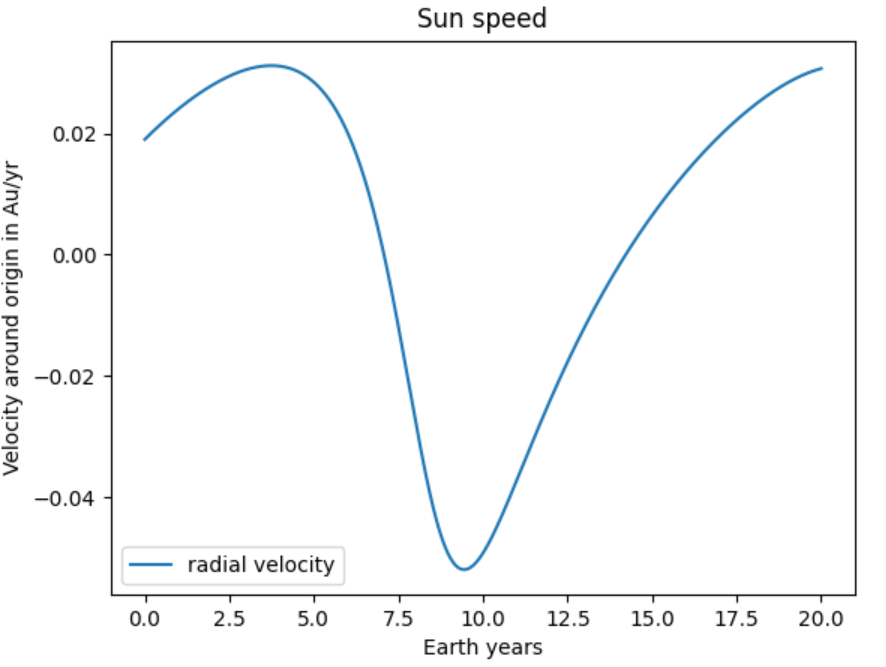
For a quick refresher; the doppler effect occurs when a light emitting object has a velocity compared to us. If it's velocity is positive, meaning it's moving away from us (\(\vec{r}\), the distance between us and the star, increases), the wavelenght is stretched out and the light becomes more red'ish and vice verca when it moves against us. When looking at stars in the night sky we're able to observe this effect, and the result is a wavy sin- or cosine-like curve as you see to our left. Where the peaks are the radial velocity, aka the max speed we can observe and the minimum estimate for the actual speed of the star. A radial velocity of the star means it's being pulled by another massive body, and we can the determine there's at least one planet there!
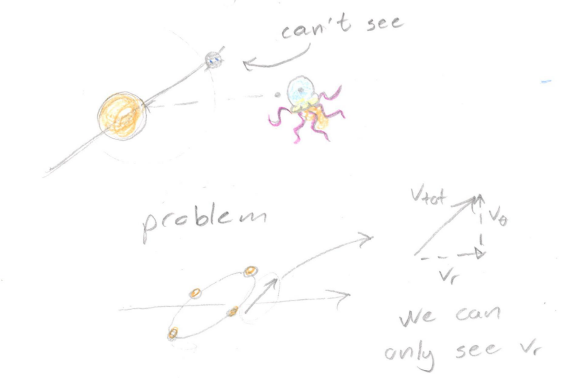
To understand why it's the minimum we observe, we're going to have to take a deeper look at the incline of a solar system, cause it direclty impacts our ability to derive information from it. When the system is inclined, it means the orbits of the planets around the star aren't parallell to our line of sight, meaning we're unable to observe both the tangential speed, which will be the horizontal normal on our line of sight, or the inclination speed, which will be the normal on our line of sight vertically. We're in other words only able to see a part of the speed, and this means we can't see the full extent of a planets affect on the star. We're still able to find information about the planet, like its minimum mass by using the improved version of Kepler's 3rd law: \(p^2=\frac{4\pi^2 a^3}{G m_* + m_p}\) p being the planets period, a being the radius of one object around the other, G being the gravitational constant, \(m_*\) being the mass of the star and \(m_p\) being the mass of the planet. We're able to observe p2, \(m_*\) and \(v_*\) if we now do some rewriting of the formula we get \(p^3 = \frac{p(v_* + v_p)^3}{2\pi G(m_* + m_p)}\) since \(m_p\) and \(v_*\) are a lot smaller than their counterparts, we set them to 0 since our measurments are innacurate enough for this to be a reasonable assumption to make, although this seems counter intuative, as we want to find \(m_p\). To bypass this we can use a relation from the two body problem to solve this dilemma: \(\frac{m_p}{m_*} = \frac{a_*}{a_p} = \frac{v_*}{v_p} => v_p = \frac{m_*}{m_p}v_*\). If we put this into our simplified expression for p, we get: \(m_* = \frac{p}{2\pi G}\frac{m_*^3}{m_p^3}v_*^3 => m_p = (\frac{p}{2\pi G})^{1/3} m_*^{2/3}v_*\).
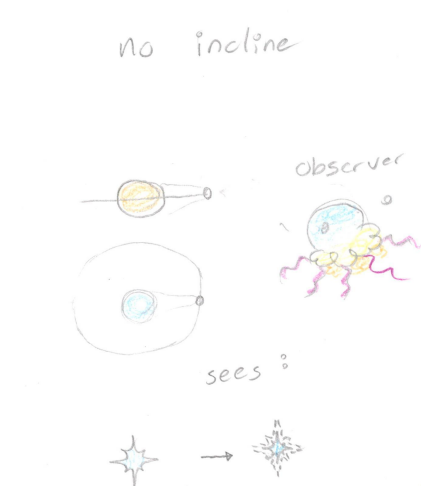
But to get a little more out of our observations we'd need the system to have no incline. But how would you know if there is, or isn't an incline? When a star has no incline, or next to none, we'll actually be able to see a slight dimming in its emitted light as a planet passes between the star and us, as seen at the bott om of the picture to the left. Much like a lunar eclipse, but with a way smaller dimming. When this happens we can actually figure out the radius and the velocity of the planet and of the star. How you may ask? Well the star emmits a constant flux against us, even though the wavelenght isn't constant. When a planet starts passing in fromt we can see a drop in this flux, but then it stabilises at a slightly lower flux while the planet passes in front, then increases as the planet
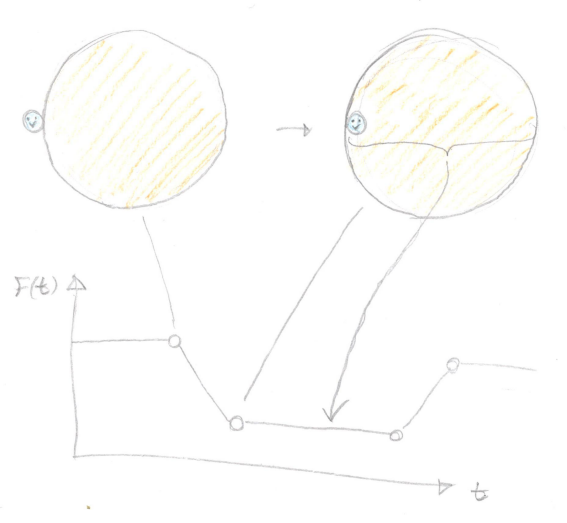
finishes its voyage. Since we now know we're observing a system with no incline we can conclude we're observing the full extent of the radial velocity, since there is no inclination to the speed in a system with no incline. We can then use the furmulas just shown to find both planet mass, and velocity. Once we know thse it's a simple matter of looking at the time it takes from the planet starts crossing the 'horizon' of the sun, until it's completely come across, like illustrated in the picture to the right.
Sometimes we're even able to observe information about the atmospheric composition of the planets as the light from the star passes through it. By use of an absorption spectrum.
Lastly I wanted to touch a bit on the use of leapfrog from earlier, as this is the numerical method we'd be using to model planet orbits once we found enough information. The reason we elect to use exacltly this method over say Euler or RungeKutta is due to it's inherant preservation of enregy, which isn't something the other two are particularly good at. So using them may result in a planet gaining or losing a lot of speed for no reason. Of course we'd ideally want to solve for the system numerically, and it's sorta what we do when comparing the numerical orbits with keplers laws. You just require some more information to use these, which we might not always have at our disposal.
 Day 4390, I think the walls have stars on them, and I am becoming one with this ever expanding cosmological wall of infinate fade into the blackness... Reality is fleating, my Chichiyakuian possesions meaningless... All that matters now is my telesco-
Day 4390, I think the walls have stars on them, and I am becoming one with this ever expanding cosmological wall of infinate fade into the blackness... Reality is fleating, my Chichiyakuian possesions meaningless... All that matters now is my telesco-
WHY HAVE YOU PADLOCKED THE ROOM?!
Privacy.
WITH 42 PADLOCKS AND A JOKE ON A STICKY NOTE ABOUT SOME WHALE AND A POTTED PLANT FALLING TO A PLANETS SURFACE?!
I was just finishing my shower and, naturally, while holding my towel in one hand, preparing for an interstellar voyage, I had to make the reference.
Too bad we can't travel at the speed of bad news huh.
Join us next time as we procrastinate more, by explaining why a star wobbles!
